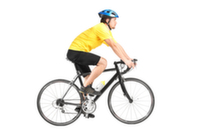Greetings
 Welcome to our August Newsletter. Today we are talking about enjoying the benefits of cycling.
Welcome to our August Newsletter. Today we are talking about enjoying the benefits of cycling.
Cycling can play an important role in a speedy recovery from certain injuries and maintaining overall health.
Whether you are exercising in your physical therapist’s office or at home, cycling can be a fun, safe and effective way to improve joint health, muscle tone, lung capacity and cardiovascular function.
When recovering from a lower extremity injury or surgery your doctor may suggest some low- or no-impact workouts to strengthen your muscles and the newly repaired joint. Cycling is often an easy and accessible option for most patients to include in their rehabilitation. Just because low- and no-impact exercises are gentler on your joints does not make them any less beneficial for strengthening muscles and increasing cardiovascular health. Even if you are a healthy individual looking for a way to maintain joint and muscle strength, cycling is something to consider.
If you need more reasons to cycle, consider these:
- Cycling is a year-round activity. If you pick up this activity outdoors in the spring or summer, you can invest in a stationary bike or a mount for your favorite bicycle to maintain your schedule in any weather.
- Cycling is practical. Depending on where you live, you may be able to bike to work or to the store. If you need a little extra motivation, think of the savings if you bike somewhere you would have otherwise driven to in a car.
- Cycling is good for your brain. Cycling is not just for physical health. Research has shown that cycling can improve cognitive performance.

- Cycling is fun. Most areas have scenic bike trails and many old railways are being converted to bike trails through the Rails-to-Trails program. We have all heard “the more, the merrier.” Find a fitness partner or a group class for your cycling. Not only can it make for a more enjoyable workout, but fitness partners also increase the success of your workout for all ages.
Although cycling is something that almost anyone can do, there are still certain precautions to consider before pedalling.
- Get ready. Ensure you are properly fitted to your bike. Properly adjusting your seat height can reduce strain and make for a more enjoyable ride.Your physiotherapist can help you with a proper bike fit.
- Warm up. As with any exercise, a good warm-up can better prepare you for your workout and reduce injury.
- Be safe. Check with your physical therapist before beginning any new exercise. Wear a helmet that fits and be aware of your surroundings. If you are cycling in town, remember that most traffic laws apply to cars as well as bicycles. Your local cycling association can help you with safety tips.
- Have fun. Exercise regimens are not meant to be chores. Find a pace and a place that make you feel comfortable.
Cycling is a low-impact exercise that may be a great addition to your treatment and long-term plans. Please consult your physical therapist at Iron City Physical Therapy to determine if cycling is the next exercise to add to your regimen.
References
- Vogt T, Schneider S, Anneken V, Strüder HK. Moderate cycling exercise enhances neurocognitive processing in adolescents with intellectual and developmental disabilities. Res Dev Disabil. 2013; 34(9):2708-16.
- Lopes VP1, Gabbard C, Rodrigues LP. Physical activity in adolescents: examining influence of the best friend dyad. J Adolesc Health. 2013; 52(6):752-6.
- Irwin BC1, Scorniaenchi J, Kerr NL, Eisenmann JC, Feltz DL. Aerobic exercise is promoted when individual performance affects the group: a test of the Kohler motivation gain effect. Ann Behav Med. 2012; 44(2):151-9.
- Bini RR, Hume PA, Kilding AE. Saddle height effects on pedal forces, joint mechanical work and kinematics of cyclists and triathletes. Eur J Sport Sci. 2014; 14(1):44-52.
- Finding the right bike fit for you. American Physical Therapy Association. PT Magazine of Physical Therapy. 2006: 14;4-5.